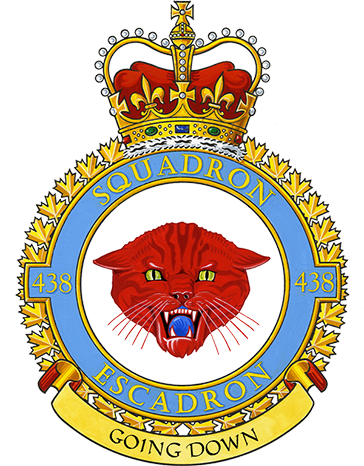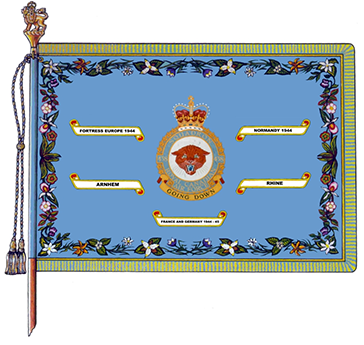438 Tactical Helicopter Squadron
The official lineage of the 438 Tactical Helicopter Squadron.

Squadron standard

Badge
Description
Argent the head of a wildcat affronté Gules langued Azure.
Significance
The wildcat represents the squadron's nickname. The motto is taken from the last instructions of the formation leader when the Second World War Typhoon fighter bombers of this unit were about to attack.
Motto
GOING DOWN
Battle honours
The Second World War
FORTRESS EUROPE, 1944; FRANCE AND GERMANY, 1944-1945; Normandy, 1944; Arnhem; Rhine.
Lineage
- Authorized as 'No.18 (Bomber) Squadron' 1 September 1934.Footnote 1
- Redesignated 'No.118 (Bomber) Squadron' 15 November 1937.Footnote 2
- Redesignated 'No.118 (Coast Artillery Co-Operation) Squadron' 1 September 1939.Footnote 3
- Redesignated 'No.118 (Fighter) Squadron' 8 August 1940.Footnote 4
- Disbanded 27 September 1940.Footnote 5
- Reformed 13 January 1941.Footnote 6
- Redesignated '438 (Fighter Bomber) Squadron' 10 November 1943.Footnote 7
- Disbanded 7 September 1945.Footnote 8
- Reformed 15 April 1946.Footnote 9
- Redsignated '438 (Fighter) Squadron' 1 April 1947.Footnote 10
- Redesignated '438 "City of Montreal" (Fighter) Squadron' 1 May 1950.Footnote 11
- Redesignated '438 Squadron' 1 November 1958.Footnote 12
- Redesignated '438 Squadron (Auxiliary)' 22 February 1964.Footnote 13
- Redesignated '438 Air Reserve Squadron' 1 January 1969.Footnote 14
- Redesignated '438 Tactical Aviation Squadron' 22 October 1991.Footnote 16
- Redesignated '438 Tactical Helicopter Squadron' 1 April 1993.Footnote 17
Operational history
The Second World War
The squadron flew on air defence operations on the Atlantic and Pacific coasts and in Alaska under 'Eastern Air Command', 'No.3 Training Command' and 'Western Air Command'. After its transfer overseas, the squadron served on air defence and bombing operations in Great Britain, France, Belgium and the Netherlands under 'Fighter Command' and '2nd Tactical Air Force'. It remained in Germany after the war with 'British Air Forces of Occupation (Germany)'.Footnote 18
Page details
- Date modified: